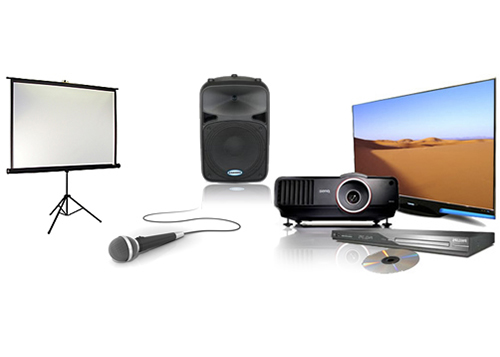The hidden benefits of using audio visual charlotte nc for training sessions
Wiki Article
Comprehending the Incorporation of Audio Visual Modern technology in Today's Educational Environments
The integration of audio-visual innovation in educational setups has actually changed the teaching and finding out process. Educators now have access to tools that satisfy numerous finding out styles, boosting pupil involvement and partnership. The consolidation of these innovations provides both possibilities and obstacles. Comprehending just how to properly implement these devices is crucial. What methods can teachers use to take full advantage of the advantages of audio-visual technology in their class?The Advancement of Audio-Visual Modern Technology in Education
As instructional requirements evolved over the years, audio-visual innovation underwent substantial makeovers that reshaped the understanding atmosphere. Tools such as film projectors and slide programs were the main methods of incorporating visual aspects right into class. These early technologies given educators with the capability to present information dynamically, yet they were limited in access and interactivity.With the introduction of videotape recorder in the 1970s, class began to integrate taped lessons, expanding the scope of instructional resources. The introduction of individual computers in the 1980s additional reinvented this landscape, allowing for the development of multimedia discussions and interactive learning experiences.
The increase of the web in the 1990s marked a pivotal minute, making it possible for real-time accessibility to a wide range of audio-visual materials. Today, electronic tools such as interactive white boards and on the internet knowing platforms proceed to improve the educational experience, cultivating interaction and partnership amongst learners.
Advantages of Audio-Visual Tools for Diverse Knowing Styles
Audio-visual devices play an important function in accommodating varied learning styles by improving aesthetic discovering and enhancing acoustic involvement. By including photos, videos, and audio, these innovations create an even more comprehensive educational atmosphere. This multifaceted strategy allows instructors to attend to the varied preferences and requirements of students efficiently.Enhancing Visual Knowing
Interaction in the understanding procedure is considerably improved with the use of audio-visual devices, dealing with various discovering styles. These devices, such as video clips, infographics, and interactive discussions, offer aesthetic stimuli that aid understanding and retention. Aesthetic students, in specific, benefit from the incorporation of images and animations, which can simplify complicated concepts and improve understanding. In addition, audio-visual sources can illustrate real-world applications, making finding out more appropriate and appealing. By integrating shade, motion, and audio, educators can create a dynamic knowing setting that records trainees' attention and promotes much deeper cognitive connections. Inevitably, the calculated use audio-visual modern technology not just sustains visual learning however also enriches the overall academic experience for varied learners.Improving Auditory Interaction
A significant advantage of incorporating audio-visual devices in education and learning is their capability to improve acoustic involvement among students. These devices, which include multimedia presentations, podcasts, and interactive sound aspects, deal with different discovering styles, especially benefiting acoustic students (audio visual charlotte nc). By incorporating noise and narrative, instructors can produce immersive experiences that record pupils' interest and reinforce understanding. This interaction is important, as it cultivates a much deeper understanding of the product and promotes retention. Additionally, audio-visual tools can help with collaborative understanding settings, encouraging pupils to take part in conversations and share their understandings. Inevitably, the consolidation of audio-visual innovation not only supports acoustic involvement however additionally enriches the general instructional experience, making discovering more dynamic and effective for all studentsEnhancing Engagement Through Interactive Learning

Gamification elements, such as tests and simulations, can enhance inspiration and retention, making finding out extra delightful and effective. These methods not just stimulate cognitive engagement but also satisfy varied discovering designs, ensuring that all pupils can take part meaningfully. Consequently, interactive learning settings foster a feeling of area and belonging, ultimately causing boosted academic end results. Through the combination of audio visual innovation, instructors can transform conventional class right into vivid spaces where students flourish and proactively form their educational trips.
Connecting Concept and Technique With Multimedia Resources
Multimedia sources offer as an important web link in between theoretical principles and practical application in academic setups. By enhancing engagement, promoting collaborative understanding experiences, and sustaining diverse discovering styles, these devices create an extra inclusive and vibrant discovering atmosphere - audio visual charlotte nc. This approach not just promotes much deeper understanding but also prepares pupils for real-world obstacles
Enhancing Engagement Via Multimedia
Interaction in educational settings substantially boosts when instructors integrate multimedia resources into their teaching strategies. The use of videos, podcasts, and interactive presentations improves the discovering experience, allowing pupils to get in touch with the product on multiple degrees. Multimedia sources provide to various discovering styles, offering aesthetic, acoustic, and kinesthetic stimuli that can hold pupils' focus better than standard lecture approaches. Additionally, these resources can streamline intricate principles, making them extra available and memorable. By incorporating multimedia, educators can produce a dynamic classroom atmosphere that cultivates interest and motivates learners. Eventually, the strategic use audio-visual modern technology offers to bridge the gap in between theoretical expertise and useful application, improving the academic experience for both instructors and students.Helping With Collaborative Knowing Experiences
Numerous researches suggest that collective understanding experiences substantially improve student end results when integrated with multimedia resources. Multimedia devices help with interaction among trainees, allowing them to involve in analytical and vital assuming collectively. By utilizing video conferencing, joint systems, and interactive presentations, instructors develop settings for team effort and shared learning. These modern technologies allow students to connect their concepts effectively and obtain instant feedback, promoting a deeper understanding of the subject matter. In addition, multimedia sources can provide complex ideas in even more absorbable formats, promoting conversation and collaboration. As an outcome, the mix of collective knowing and audio-visual technology not only enriches the educational experience but also prepares students for real-world team effort dynamics, highlighting the relevance of cooperation and cumulative knowledge building.Supporting Diverse Knowing Styles
While conventional teaching methods commonly accommodate a minimal variety of learning choices, the assimilation of audio-visual technology offers a much more inclusive method to education and learning. By using multimedia sources such as video clips, interactive simulations, and digital presentations, instructors can address various finding out designs, consisting of visual, auditory, and kinesthetic. This versatility enables separated direction, allowing pupils to engage with web content in ways that reverberate with their private choices. In addition, audio-visual tools can help with much deeper understanding by offering numerous depictions of complicated concepts. As a result, trainees who may deal with standard techniques can find alternate paths to success, cultivating a more equitable knowing moved here environment that sustains academic achievement for all learners.Obstacles in Implementing Audio-Visual Technology
Although audio-visual technology holds wonderful assurance for enhancing educational experiences, its execution usually experiences significant obstacles. One primary worry is the economic burden connected with purchasing and maintaining such devices, which can strain budgets, specifically in underfunded organizations. In addition, inadequate training for teachers can prevent reliable combination, leaving them ill-prepared to use the modern technology fully. Technical issues, such as software application breakdowns and compatibility troubles, might likewise interfere with lessons and annoy both educators and trainees. Varying levels of trainee access to technology outside the class can develop differences in discovering possibilities. Lastly, the possibility for over-reliance on technology might diminish crucial mentor techniques, inevitably limiting the instructional experience. Addressing these difficulties calls recommended you read for a detailed strategy, consisting of sufficient funding, professional advancement, and fair accessibility to resources, to ensure that audio-visual innovation can be leveraged successfully in today's instructional settings.Ideal Practices for Integrating Modern Technology in the Classroom

Additionally, cultivating an interactive environment via joint tools encourages pupil involvement and participation. Utilizing varied audio-visual sources satisfies numerous discovering designs, accommodating aesthetic, acoustic, and kinesthetic students. Regularly examining the influence of modern technology on student discovering helps teachers improve their techniques and adapt to altering needs. Finally, including students in the option of modern technology promotes ownership and inspiration. By adhering to these ideal methods, educators can create a dynamic classroom ambience that successfully incorporates technology and boosts the instructional experience for all students.
The Future of Audio-Visual Innovation in Education And Learning
As class increasingly welcome modern technology, the landscape of audio-visual tools in education and learning continues to progress (audio visual charlotte nc). Future improvements are expected to focus on better interactivity and personalization, enabling educators to customize discovering experiences to private student requirements. Technologies such as increased fact (AR) and digital fact (VIRTUAL REALITY) will likely supply immersive discovering environments, improving student engagement and understanding
Additionally, man-made knowledge (AI) is poised to play a considerable function in audio-visual technology by offering real-time comments and flexible understanding paths. This combination might assist instructors identify and deal with student obstacles better. Cloud-based systems will facilitate much easier access to sources and cooperation among pupils and teachers, regardless of location.
Along with these technological breakthroughs, professional development for instructors will certainly be crucial, guaranteeing they are outfitted to make use of these tools successfully. On the whole, the future of audio-visual technology in education assures to develop even more dynamic, comprehensive, and impactful discovering experiences.
Regularly Asked Inquiries
How Can Teachers Pick the Right Audio-Visual Devices for Their Classrooms?
Choosing proper audio-visual tools calls for educators to evaluate their educational objectives, take into consideration trainee requirements, review available technology, and look for suggestions from peers or specialists, ensuring tools properly boost understanding and interaction within their certain class setting.What Spending plan Considerations Are There for Implementing Audio-Visual Innovation?
Spending plan factors to consider for carrying out audio-visual modern technology include first acquisition prices, upkeep costs, training for staff, and potential software licensing fees. In addition, lasting investment in updates and substitutes must likewise be factored into economic preparation.Exist Specific Training Resources for Teachers on Audio-Visual Devices?
Several organizations use training sources for teachers on audio-visual devices, consisting of online programs, workshops, and instructional guides. These resources aim to enhance instructors' abilities and self-confidence in properly integrating modern technology right into their training practices.Exactly how Do We Gauge the Effectiveness of Audio-Visual Innovation in Understanding?
Gauging the performance why not check here of audio-visual technology in finding out includes assessing trainee engagement, comprehension, retention prices, and overall scholastic efficiency. Studies, evaluations, and empirical research studies can provide useful insights right into its influence on academic outcomes.What Prevail False Impressions Concerning Audio-Visual Modern Technology in Education?
Typical mistaken beliefs concerning audio-visual modern technology in education include the idea that it guarantees involvement and finding out outcomes, along with the assumption that all trainees benefit just as, ignoring individual discovering preferences and demands.Report this wiki page